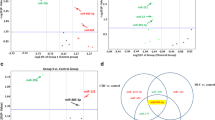Abstract
Hepatocellular carcinoma (HCC) is a serious consequence of persistent hepatitis C virus (HCV) infection and represents one of the most aggressive neoplasms globally. The implication of microRNA-301 (miR-301) in the initiation and progression of different types of cancers has been proved. We aimed to assess circulating microRNA-301 as possible biomarker for the early detection of HCC in patients with chronic HCV infection. miR-301 expression levels were estimated in plasma samples of 42 patients with newly diagnosed HCV-related HCC, 48 chronically HCV infected patients with liver cirrhosis and 40 healthy individuals by reverse transcription-quantitative polymerase chain reaction technique. In comparison with chronically HCV infected patients and healthy controls, miR-301 expression levels were significantly increased in HCC patients (P < 0.001). miR-301 levels distinguished HCC patients from chronic HCV patients, with area under the receiver–operating characteristic curve of 0.89 (95% CI 0.82–0.96), the sensitivity and the specificity were 78.57% and 89.58% respectively. Moreover, miR-301 levels were significantly linked with tumor size (P = 0.014), serum levels of alpha-fetoprotein (AFP) (P = 0.028) and Barcelona Clinic Liver Cancer (BCLC) score (P = 0.003). These results reveal that miR-301 can serve as a promising non-invasive biomarker for diagnosis of HCC in chronically HCV infected patients.


Similar content being viewed by others
References
Baumert TF, Jühling F, Ono A, Hoshida Y (2017) Hepatitis C-related hepatocellular carcinoma in the era of new generation antivirals. BMC Med 15:52
Yim SY, Seo YS, Jung CH, Kim TH, Lee JM, Kim ES et al (2016) The management and prognosis of patients with hepatocellular carcinoma: what has changed in 20 years? Liver Int 36:445–453
Siegel RL, Miller KD, Jemal A (2017) Cancer statistics, 2017. CA Cancer J Clin 67:7–30
Kim JU, Shariff MI, Crossey MM, Gomez-Romero M, Holmes E, Cox IJ et al (2016) Hepatocellular carcinoma: review of disease and tumor biomarkers. World J Hepatol 8:471–484
Fiorino S, Bacchi-Reggiani ML, Visani M, Acquaviva G, Fornelli A, Masetti M et al (2016) MicroRNAs as possible biomarkers for diagnosis and prognosis of hepatitis B- and C-related-hepatocellular-carcinoma. World J Gastroenterol 22:3907–3936
Takasaki S (2015) Roles of microRNAs in cancers and development. Methods Mol Biol 1218:375–413
Oliveto S, Mancino M, Manfrini N, Biffo S (2017) Role of microRNAs in translation regulation and cancer. World J Biol Chem 8:45–56
Berindan-Neagoe I, Monroig Pdel C, Pasculli B, Calin GA (2014) Micro RNAome genome: a treasure for cancer diagnosis and therapy. CA Cancer J Clin 64:311–336
Zhou L, Liu F, Wang X, Ouyang G (2015) The roles of microRNAs in the regulation of tumor metastasis. Cell Biosci 5:32
Halvorsen AR, Helland Å, Gromov P, Wielenga VT, Talman MM, Brunner N et al (2017) Profiling of microRNAs in tumor interstitial fluid of breast tumors—a novel resource to identify biomarkers for prognostic classification and detection of cancer. Mol Oncol 11:220–234
Chan E, Prado DE, Weidhaas JB (2011) Cancer microRNAs: from subtype profiling to predictors of response to therapy. Trends Mol Med 17:235–243
Manterola L, Guruceaga E, Gállego Pérez-Larraya J, González-Huarriz M, Jauregui P, Tejada S et al (2014) A small noncoding RNA signature found in exosomes of GBM patient serum as a diagnostic tool. Neuro Oncol 16:520–527
Shi W, Gerster K, Alajez NM, Tsang J, Waldron L, Pintilie M et al (2011) MicroRNA-301 mediates proliferation and invasion in human breast cancer. Cancer Res 71:2926–2937
Wang G, Qiu L, Deng J, Shao H, Miao Y (2016) The research of miR-301 in gastric cancer cell proliferation and apoptosis. Int J Clin Exp Med 9:15526–15532
Zhang W, Zhang T, Jin R, Zhao H, Hu J, Feng B et al (2014) MicroRNA-301a promotes migration and invasion by targeting TGFBR2 in human colorectal cancer. J Exp Clin Cancer Res 33:113
Llovet JM, Ducreux M, Lencioni R, Di Bisceglie AM, Galle PR, Dufour JF et al (2012) EASL-EORTC clinical practice guidelines: management of hepatocellular carcinoma. J Hepatol 56:908–943
Bimonte S, Leongito M, Barbieri A, Del Vecchio V, Falco M, Giudice A et al (2016) The therapeutic targets of miRNA in hepatic cancer stem cells. Stem Cells Int 2016:1065230
Dhanasekaran R, Limaye A, Cabrera R (2012) Hepatocellular carcinoma: current trends in worldwide epidemiology, risk factors, diagnosis, and therapeutics. Hepat Med 4:19–37
Afonso MB, Rodrigues PM, Simão AL, Castro RE (2016) Circulating microRNAs as potential biomarkers in non-alcoholic fatty liver disease and hepatocellular carcinoma. J Clin Med 5:E30
Wang Y, Tian Y (2016) miRNA for diagnosis and clinical implications of human hepatocellular carcinoma. Hepatol Res 46:89–99
Thurnherr T, Mah WC, Lei Z, Jin Y, Rozen SG, Lee CG (2016) Differentially expressed miRNAs in hepatocellular carcinoma target genes in the genetic information processing and metabolism pathways. Sci Rep 6:20065
Yu Q, Yang X, Duan W, Li C, Luo Y, Lu S (2017) miRNA-346 promotes proliferation, migration and invasion in liver cancer. Oncol Lett 14:3255–3260
Giordano S, Columbano A (2013) MicroRNAs: new tools for diagnosis, prognosis, and therapy in hepatocellular carcinoma? Hepatology 57:840–847
Zhou P, Jiang W, Wu L, Chang R, Wu K, Wang Z (2012) miR-301a is a candidate oncogene that targets the homeobox gene Gax in human hepatocellular carcinoma. Dig Dis Sci 57:1171–1180
He K, Hu Z, Ruan J, Ma Q, Zhong F, Cheng X et al (2015) MicroRNA301 is a potential diagnostic biomarker for hepatocellular cancer. Int J Clin Exp Pathol 8:5603–5608
Cun Y, Fröhlich HF (2012) Prognostic gene signatures for patient stratification in breast cancer: accuracy, stability and interpretability of gene selection approaches using prior knowledge on protein-protein interactions. BMC Bioinform 13:69
Funding
None.
Author information
Authors and Affiliations
Corresponding author
Ethics declarations
Conflict of interest
The authors confirm that there are no known conflicts of interest.
Additional information
Publisher's Note
Springer Nature remains neutral with regard to jurisdictional claims in published maps and institutional affiliations.
Rights and permissions
About this article
Cite this article
El-Hamouly, M.S., Azzam, A.A., Ghanem, S.E. et al. Circulating microRNA-301 as a promising diagnostic biomarker of hepatitis C virus-related hepatocellular carcinoma. Mol Biol Rep 46, 5759–5765 (2019). https://doi.org/10.1007/s11033-019-05009-w
Received:
Accepted:
Published:
Issue Date:
DOI: https://doi.org/10.1007/s11033-019-05009-w




